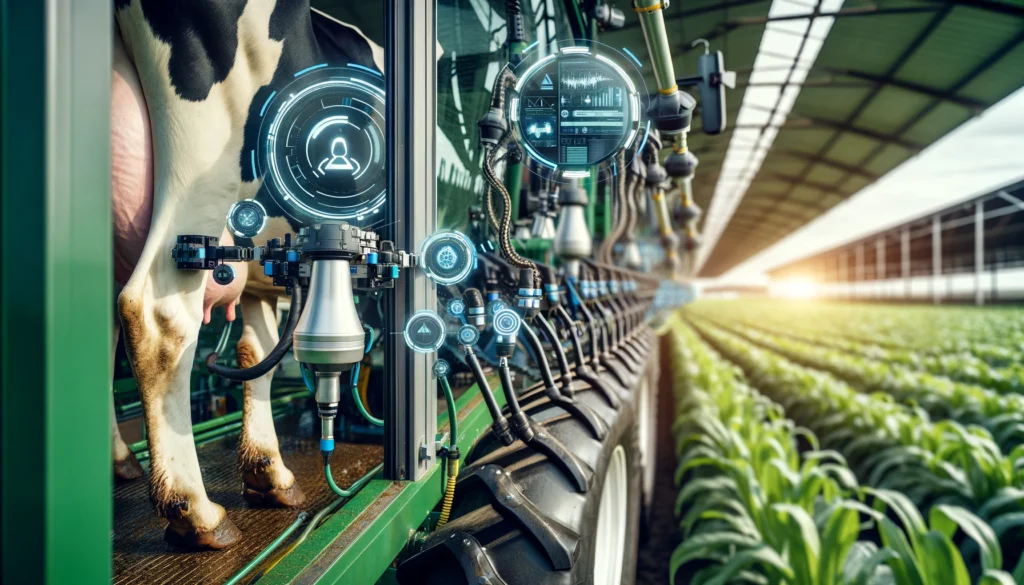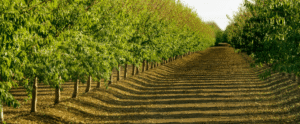
Agriculture Dictionary A close up shot of automated systems on a modern farm. The focus is on an automated tractor with sensors and control panels a robotic arm milking a c1.webp.webp
Definition: Automated Systems on a Farm
Automated systems on a farm refer to the use of technology and machinery that operate with minimal human intervention to perform various agricultural tasks. These systems include automated irrigation, milking robots, autonomous tractors, and climate control systems for greenhouses. The goal of farm automation is to enhance efficiency, reduce labor costs, improve precision, and increase overall productivity. Automated systems leverage advanced technologies such as sensors, robotics, artificial intelligence (AI), and the Internet of Things (IoT) to optimize farming operations and support sustainable agriculture.
Automated Systems on a Farm: An In-Depth Guide
Introduction
Automated systems are transforming the agricultural landscape by providing farmers with advanced tools to enhance efficiency, productivity, and sustainability. This guide explores the various types of automated systems used in farming, their benefits, and best practices for implementation and use. Understanding these technologies can help farmers optimize their operations and achieve better outcomes.
Fall off the barn roof and busted your keister? Life on the farm or ranch can be tough on the bum. Need a break? Laugh it off at FarmerCowboy.com, the #1 farm humor site. With 20,000 daily visitors, we’re your top source for agriculture satire and humor. Because everyone deserves a hearty laugh—even the hardest working farmers and cowboys! Join us and turn those long days into fun tales at FarmerCowboy.com.
Types of Automated Systems on a Farm
Automated systems in agriculture can be categorized based on their applications in different farming activities:
1. Automated Irrigation Systems
Automated irrigation systems use sensors and controllers to manage water application precisely. These systems include:
- Drip Irrigation: Delivers water directly to the plant roots through a network of tubes and emitters, optimizing water use.
- Sprinkler Systems: Automated sprinklers provide uniform water distribution over large areas.
- Soil Moisture Sensors: Measure soil moisture levels and adjust irrigation schedules accordingly.
2. Milking Robots
Milking robots automate the process of milking cows, reducing labor requirements and improving animal welfare. Key features include:
- Automatic Milking Systems (AMS): Robots attach to the cows and perform the milking process, while sensors monitor milk quality and cow health.
- Feeding Systems: Automated feeders ensure cows receive the right amount of feed based on their individual needs.
3. Autonomous Tractors and Machinery
Autonomous tractors and machinery perform tasks such as planting, tilling, and harvesting without human intervention. Examples include:
- Self-Driving Tractors: Equipped with GPS and sensors for precise navigation and operation.
- Robotic Harvesters: Machines that automate the harvesting of crops like fruits and vegetables.
4. Climate Control Systems for Greenhouses
Automated climate control systems regulate temperature, humidity, and light levels in greenhouses to optimize plant growth. Components include:
- Ventilation Systems: Automatically adjust vents and fans to control temperature and humidity.
- Lighting Systems: Provide supplemental light to extend growing seasons or improve plant health.
- Heating and Cooling Systems: Maintain optimal temperatures for plant growth.
5. Automated Feeding Systems
Automated feeding systems ensure livestock receive the right amount of feed at the right times. These systems include:
- Feed Dispensers: Distribute feed based on pre-set schedules or animal needs.
- Monitoring Systems: Track feed consumption and adjust feeding plans accordingly.
Benefits of Automated Systems on a Farm
Implementing automated systems offers numerous benefits:
- Increased Efficiency: Automation streamlines farming operations, reducing the time and labor required for various tasks.
- Cost Savings: Automated systems reduce labor costs and optimize resource use, leading to significant cost savings.
- Enhanced Precision: Automation improves the accuracy of tasks such as planting, watering, and feeding, leading to better crop yields and animal health.
- Improved Sustainability: Automated systems promote sustainable practices by minimizing waste and conserving resources like water and energy.
- Better Decision-Making: Data collected from automated systems helps farmers make informed decisions and improve overall farm management.
Challenges in Implementing Automated Systems
Despite their benefits, implementing automated systems can present several challenges:
- High Initial Costs: Investing in advanced automation technology requires significant capital, which can be a barrier for small and medium-sized farms.
- Technical Complexity: Operating and maintaining automated systems requires specialized knowledge and training.
- Data Management: Managing and interpreting the large amounts of data generated by automated systems can be challenging.
- Integration Issues: Integrating new automation systems with existing equipment and practices can be complex and time-consuming.
- Dependence on Infrastructure: Reliable internet connectivity and power supply are essential for the effective use of many automated systems.
Best Practices for Implementing Automated Systems
To maximize the benefits of automated systems, consider the following best practices:
1. Conduct a Needs Assessment
Evaluate your farm’s specific needs and challenges to identify the most suitable automation technologies. Consider factors such as crop type, field size, and resource availability.
2. Invest in Training
Ensure that all operators and farm workers receive proper training on using automated systems. This includes understanding how to operate the technology, interpret data, and perform routine maintenance.
3. Start Small
Begin with pilot projects to test new automated systems on a small scale before full-scale implementation. This allows you to identify potential issues and make necessary adjustments.
4. Prioritize Data Management
Develop a robust data management strategy to ensure data collected from automated systems is accurate, secure, and accessible. This includes investing in reliable data storage and analytics platforms.
5. Collaborate with Experts
Work with technology providers, agricultural consultants, and research institutions to stay updated on the latest advancements and best practices in farm automation.
Case Study: Successful Implementation of Automated Systems
The Smith Family Farm
The Smith family operates a 1,000-acre dairy and crop farm. They successfully integrated various automated systems into their operations, leading to significant improvements in productivity and sustainability. Key elements of their success included:
- Automated Milking Systems: The Smiths installed milking robots, which reduced labor requirements and improved milk quality.
- Automated Irrigation: Soil moisture sensors and drip irrigation systems optimized water use, enhancing crop health and yields.
- Autonomous Tractors: Self-driving tractors improved the efficiency and accuracy of planting and harvesting operations.
- Climate Control in Greenhouses: Automated climate control systems maintained optimal growing conditions, increasing the productivity of their greenhouse crops.
Results
The Smith family’s investment in automated systems led to increased productivity, improved resource efficiency, and enhanced sustainability. The use of automation technology contributed to cost savings and better overall farm management.
Conclusion
Automated systems are essential for the efficiency and productivity of modern agricultural operations. By investing in advanced automation technology, farmers can enhance their operations and support sustainable farming practices. Understanding the different types of automated systems and best practices for their implementation and use is crucial for maximizing the benefits and ensuring the long-term success of a farm.
How Knowledge of Automated Systems Can Help Farmers
Understanding automated systems helps farmers make informed decisions about technology investments, maintenance, and upgrades. Knowledge of different types of automation and their applications enables farmers to optimize resource use, enhance productivity, and ensure the safety and welfare of their workers and livestock. This understanding also supports sustainable farming practices and long-term agricultural success.
Resources for Further Reading
To further explore automated systems and related agricultural topics, visit the following resources:
Images

Originally posted 2024-05-24 09:40:09.
Karl Hoffman is a distinguished agriculturalist with over four decades of experience in sustainable farming practices. He holds a Ph.D. in Agronomy from Cornell University and has made significant contributions as a professor at Iowa State University. Hoffman’s groundbreaking research on integrated pest management and soil health has revolutionized modern agriculture. As a respected farm journalist, his column “Field Notes with Karl Hoffman” and his blog “The Modern Farmer” provide insightful, practical advice to a global audience. Hoffman’s work with the USDA and the United Nations FAO has enhanced food security worldwide. His awards include the USDA’s Distinguished Service Award and the World Food Prize, reflecting his profound impact on agriculture and sustainability.



